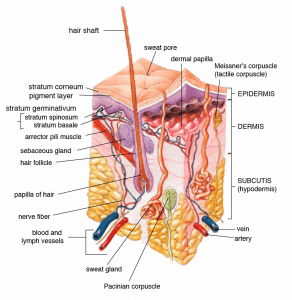
The epidermis, dermis, and subcutaneous tissue are the three layers that compose the human skin. Source: Wikimedia Commons
Skin aging is a fact of life; everyone will face it sooner or later. In order to understand how this process works, it is important to know the basics of skin. The epidermis, dermis, and subcutaneous tissue are the three layers that compose the human skin. Epidermis is the skin’s surface, a layer rich in keratin that provides toughness and water-resistance. This layer of skin is where dead cells are shed and where melanin (a dark pigment) is found. The second and thicker layer is the dermis, which is composed of nerves, fats, blood vessels, elastin, and collagen fibers, which provide elasticity. Finally, the subcutaneous layer is composed of fat, keeping us warm and holding our internal organs in place (1).
Intrinsic aging is the aging process that takes place over the years regardless of external influences. After the age of 20, one percent less of collagen is produced in the dermis each year (2). The collagen and elastin fibers become thicker, more clumped, and looser, resulting in inelastic and brittle skin and eventually in wrinkling and sagging (3). In our twenties, the skin’s exfoliation process decreases by 28% as well, causing dead skin cells to accumulate and stick together for longer periods of time. In our thirties, the transfer of moisture from the dermis to the epidermis is slowed and fat cells start to shrink. These effects make the skin look dull and thin. In our forties, collagen is no longer produced. The collagen and elastin fibers break, thicken, stiffen, clump together, and lose their elasticity. This results in wrinkles and aging lines. Finally, in our fifties, the skin becomes dry and is easily bruised, damaged, or broken because the sebaceous (oil) glands have decreased in size. In women, menopause causes a decrease in estrogen levels, leaving the skin drier, thinner, more sensitive, and less toned.
A second type of aging is extrinsic aging. Unlike the previous cause of skin aging, it can be controlled because it is a result of environmental damage. Extrinsic aging appears as a thickening of the cornified layer (outermost layer of epidermis), precancerous changes (an example is actinic keratosis), skin cancer, formation of freckles and sunspots, and huge losses of collagen, elastin, and glycosaminoglycans (GAGs). As a result of these processes, the skin becomes rough, uneven in tone, and wrinkled (2).
Free radicals (electron-hungry molecules or atoms) are the cause of these chemical changes. When electrons are pulled from other molecules, chemical structures and biological functions are altered. Environmental influences, such as pollution, smoking, and ultraviolet radiation, generate free radicals. Antioxidant enzymes and molecules, such as vitamin C, vitamin E, and carotenoid pigments, can protect us from free radicals, but their damage occurs anyway. Glucose, a fuel necessary for our bodies, presents another threat. It forms plastic-like molecules known as age-related glycation end-products (AGES) by crosslinking with proteins. These complexes hurt skin proteins by causing them to be more brittle and less elastic. Also, because the skin is the barrier between body and environment, ultraviolet radiation causes damage to DNA and molecules and results in the generation of free radicals, making it the crucial factor in the acceleration of wrinkling skin. The skin protects from damage to exposure of sunlight by producing more melanin. 3
Our body is able to repair damaged proteins, but they will not work as well. Prevention is the key to minimizing wrinkles. An SPF of at least 35 is necessary for sun protection against UVA and UVB. After the age of 25, it is recommended to use Retin-A as an anti-aging cream. It is a vitamin A derivative that can cause redness and peeling during the first two months of use, but overtime it improves fine lines, pores, brown spots, and precancerous changes. Chemical peels and non-invasive lasers can build collagen and improve the skin’s appearance too (2).
In conclusion, aging is under the control of genetic repair mechanics and can be affected by lifestyle influences. Measures to protect our skin will keep it from aging more than it needs to.
Reference
- C. Collin. How Does My Skin Anatomy Change as I Get Older? (2005). http://health.howstuffworks.com/skin-care/information/anatomy/skin-anatomy-change.htm (26 Jan 2013).
- S. Obagi. Why Does Skin Wrinkle with Age? What Is the Best Way to Slow or Prevent This Process? http://www.scientificamerican.com/article.cfm?id=why-does-skin-wrinkle-wit (27 Jan. 2013).
- M. Witmer, Unrepaired skin molecules cause wrinkles as we age (2006). http://www.ccmr.cornell.edu/education/ask/index.html?quid=1117 (26 Jan. 2013).
Leave a Reply